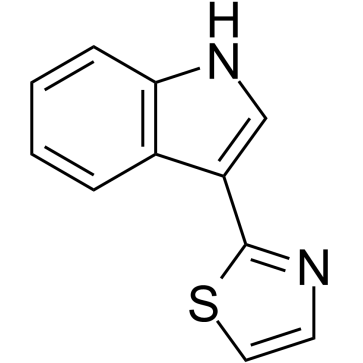| Cas No.: | 135531-86-1 |
| SMILES: | C12C(C3SC=CN=3)=CNC=1C=CC=C2 |
| Formula: | C11H8N2S |
| M.Wt: | 200.26 |
| Purity: | >98% |
| Sotrage: | 2 years -20°C Powder, 2 weeks 4°C in DMSO, 6 months -80°C in DMSO |
| Publication: | [1]. William A.Ayer, et al. Synthesis of camalexin and related phytoalexins. Tetrahedron. Volume 48, Issue 14, 1992, Pages 2919-2924. [2]. Glawischnig E. Camalexin. Phytochemistry. 2007 Feb;68(4):401-6. [3]. Mezencev R, et al. Antiproliferative and cancer chemopreventive activity of phytoalexins: focus on indole phytoalexins from crucifers. Neoplasma. 2003;50(4):239-45. |
| Description: | Camalexin is a phytoalexin isolated from Camelina sativa and Arabidopsis (Cruciferae) with antibacterial, antifungal, antiproliferative and anticancer activities. Camalexin can induce reactive oxygen species (ROS) production[1][2][3]. |
| Target: | Reactive oxygen species (ROS)[1][2] |
| In Vitro: | Camalexin shows antiproliferative activity against a human breast cancer cell line[2]. For the oomycetes Phytophthora and Pythium Nep1-like proteins (necrosis and ethylene-inducing peptide 1-like proteins) are the initial triggers of Camalexin synthesis and formation of reactive oxygen species (ROS). ROS appear to be of general relevance for Camalexin formation. Chemical induction of ROS, such as by application of acifluorfen, coincided with Camalexin synthesis. In a screen for enhanced susceptibility to Alternaria brassicicola the esa1 mutant is identified, which shows delayed Camalexin induction. Particularly in response to ROS inducing agents reduced Camalexin levels are synthesized. This crucial role for ESA1 is confirmed by the inability of esa1 mutants to synthesize Camalexin in response to Leptosphaeria maculans. An additional mutant that exhibits greatly reduced Camalexin accumulation is ups1, which is isolated on the basis of diminished expression of a tryptophan biosynthetic enzyme[2]. |
| References: | [1]. William A.Ayer, et al. Synthesis of camalexin and related phytoalexins. Tetrahedron. Volume 48, Issue 14, 1992, Pages 2919-2924. [2]. Glawischnig E. Camalexin. Phytochemistry. 2007 Feb;68(4):401-6. [3]. Mezencev R, et al. Antiproliferative and cancer chemopreventive activity of phytoalexins: focus on indole phytoalexins from crucifers. Neoplasma. 2003;50(4):239-45. |

 DC Chemicals' products qualify for U.S. tariff exemptions. We guarantee no price increases due to customs duties and maintain stable supply, continuing to deliver reliable research solutions to our American clients.
DC Chemicals' products qualify for U.S. tariff exemptions. We guarantee no price increases due to customs duties and maintain stable supply, continuing to deliver reliable research solutions to our American clients.





















